BUS101 - Accounting Fundamentals: Jasmine Hotel Financial Report
VerifiedAdded on 2022/08/20
|6
|1583
|19
Report
AI Summary
This report provides a comprehensive financial analysis of the Jasmine Hotel, focusing on key accounting ratios to assess its performance and financial health. The analysis includes a detailed examination of liquidity ratios (current and quick ratios), solvency ratios (debt-to-equity ratio), and profitability ratios (gross and net profit margins) for the years 2017 and 2018. The report compares Jasmine Hotel's performance with its main competitor, Marriott Hotel, and industry standards. The findings highlight the strengths and weaknesses of Jasmine Hotel's financial position, offering insights into its ability to meet short-term obligations, manage its capital structure, and generate profits. Based on the analysis, the report provides specific recommendations for improving the hotel's financial performance, including suggestions for managing current assets, leveraging debt, and maintaining stable profit margins. The report aims to provide a clear understanding of Jasmine Hotel's financial health and offer actionable recommendations for future financial strategies.
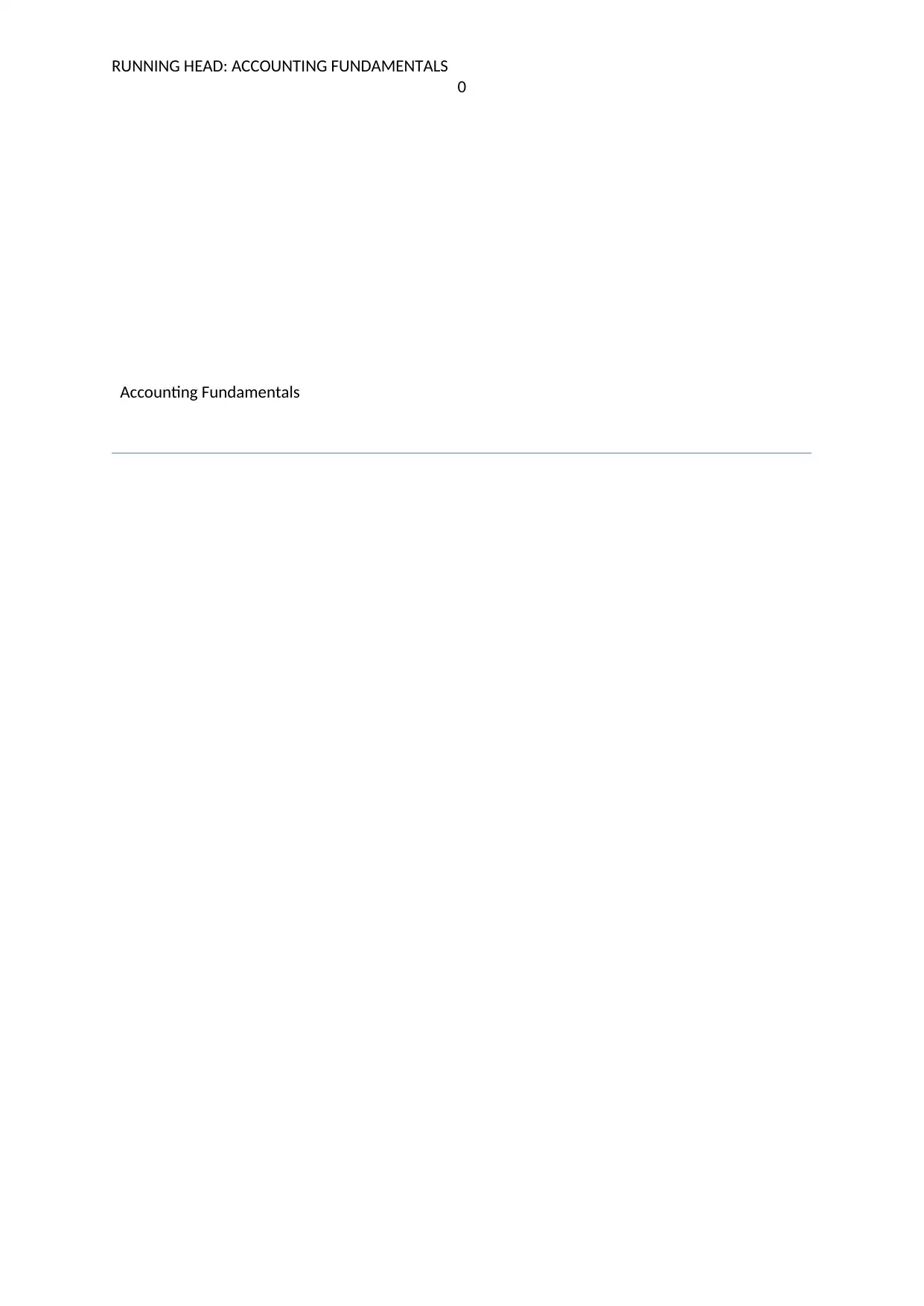
RUNNING HEAD: ACCOUNTING FUNDAMENTALS
0
Accounting Fundamentals
0
Accounting Fundamentals
Paraphrase This Document
Need a fresh take? Get an instant paraphrase of this document with our AI Paraphraser
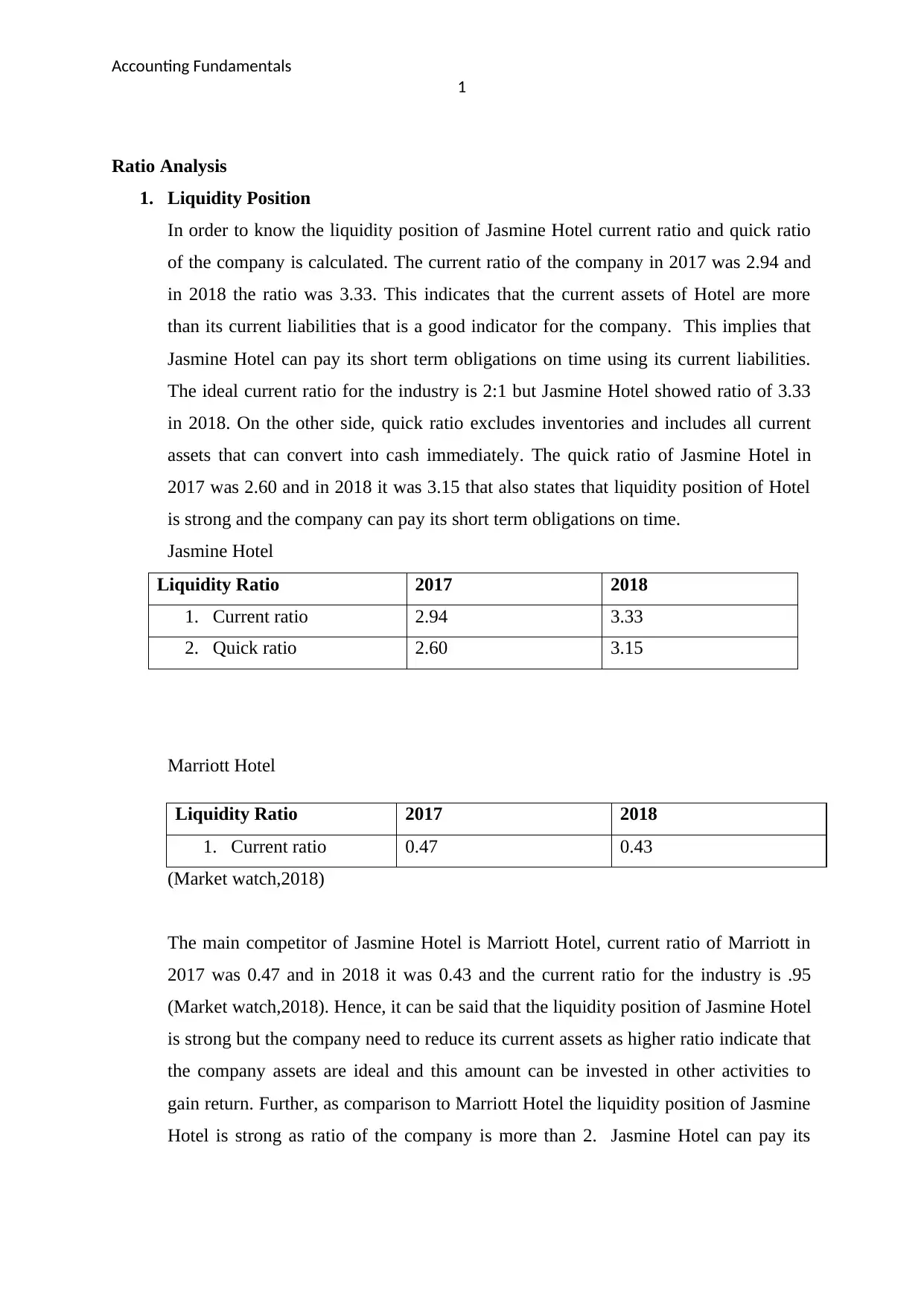
Accounting Fundamentals
1
Ratio Analysis
1. Liquidity Position
In order to know the liquidity position of Jasmine Hotel current ratio and quick ratio
of the company is calculated. The current ratio of the company in 2017 was 2.94 and
in 2018 the ratio was 3.33. This indicates that the current assets of Hotel are more
than its current liabilities that is a good indicator for the company. This implies that
Jasmine Hotel can pay its short term obligations on time using its current liabilities.
The ideal current ratio for the industry is 2:1 but Jasmine Hotel showed ratio of 3.33
in 2018. On the other side, quick ratio excludes inventories and includes all current
assets that can convert into cash immediately. The quick ratio of Jasmine Hotel in
2017 was 2.60 and in 2018 it was 3.15 that also states that liquidity position of Hotel
is strong and the company can pay its short term obligations on time.
Jasmine Hotel
Marriott Hotel
Liquidity Ratio 2017 2018
1. Current ratio 0.47 0.43
(Market watch,2018)
The main competitor of Jasmine Hotel is Marriott Hotel, current ratio of Marriott in
2017 was 0.47 and in 2018 it was 0.43 and the current ratio for the industry is .95
(Market watch,2018). Hence, it can be said that the liquidity position of Jasmine Hotel
is strong but the company need to reduce its current assets as higher ratio indicate that
the company assets are ideal and this amount can be invested in other activities to
gain return. Further, as comparison to Marriott Hotel the liquidity position of Jasmine
Hotel is strong as ratio of the company is more than 2. Jasmine Hotel can pay its
Liquidity Ratio 2017 2018
1. Current ratio 2.94 3.33
2. Quick ratio 2.60 3.15
1
Ratio Analysis
1. Liquidity Position
In order to know the liquidity position of Jasmine Hotel current ratio and quick ratio
of the company is calculated. The current ratio of the company in 2017 was 2.94 and
in 2018 the ratio was 3.33. This indicates that the current assets of Hotel are more
than its current liabilities that is a good indicator for the company. This implies that
Jasmine Hotel can pay its short term obligations on time using its current liabilities.
The ideal current ratio for the industry is 2:1 but Jasmine Hotel showed ratio of 3.33
in 2018. On the other side, quick ratio excludes inventories and includes all current
assets that can convert into cash immediately. The quick ratio of Jasmine Hotel in
2017 was 2.60 and in 2018 it was 3.15 that also states that liquidity position of Hotel
is strong and the company can pay its short term obligations on time.
Jasmine Hotel
Marriott Hotel
Liquidity Ratio 2017 2018
1. Current ratio 0.47 0.43
(Market watch,2018)
The main competitor of Jasmine Hotel is Marriott Hotel, current ratio of Marriott in
2017 was 0.47 and in 2018 it was 0.43 and the current ratio for the industry is .95
(Market watch,2018). Hence, it can be said that the liquidity position of Jasmine Hotel
is strong but the company need to reduce its current assets as higher ratio indicate that
the company assets are ideal and this amount can be invested in other activities to
gain return. Further, as comparison to Marriott Hotel the liquidity position of Jasmine
Hotel is strong as ratio of the company is more than 2. Jasmine Hotel can pay its
Liquidity Ratio 2017 2018
1. Current ratio 2.94 3.33
2. Quick ratio 2.60 3.15

Accounting Fundamentals
2
immediate liabilities effectively and the working capital flow of the company also
remains smooth without any shortage of cash for day to day activities.
2. Solvency Ratio Analysis
In order to understand the capital structure of Jasmine Hotel the debt and equity ratio
is calculated. Debt to Equity ratio is used to know the ratio of owners’ capital and
debts in the capital structure of the company. The debt equity ratio of Jasmine Hotel
in 2017 was 0.4340 and in 2018 it remains the same. As debt of Jasmine Hotel was
449745 and equity was 1036245. The proportion of debt in the capital structure is low
that indicate that financial position of Hotel is strong and the capital structure is less
risky (Hamit,2018). The maximum ratio that any company can maintain is 2:1. The
present ratio maintained by Jasmine Hotel is indicate the stable position of business
but any further decline leads to diluted liquidity situation.
Jasmine Hotel
Solvency Ratio 2017 2018
Debt to Equity ratio 0.4340 0.4340
Marriott Hotel
Solvency Ratio 2017 2018
Debt to Equity Ratio 2.19 3.83
(Market watch,2018)
On the other side, Marriott Hotel debt equity ratio for year 2017 and 2018 was 2.19
and 3.83 respectively. In comparing ratio of both companies it can be said that
Marriott Hotel capital structure is risky because of higher debt equity ratio. “Higher
the ratio, higher the proportion of debt in the capital structure” (Vogel,2016). Hence,
the financial position of Jasmine Hotel is better as the company has less debt than
equity. This represents that Jasmine Hotel can pay its long term debts smoothly.
Further, the proportion of debt in Marriott Hotel is high, this helps the company to
gain tax advantage but this increase the cost of capital for Hotel (Market
2
immediate liabilities effectively and the working capital flow of the company also
remains smooth without any shortage of cash for day to day activities.
2. Solvency Ratio Analysis
In order to understand the capital structure of Jasmine Hotel the debt and equity ratio
is calculated. Debt to Equity ratio is used to know the ratio of owners’ capital and
debts in the capital structure of the company. The debt equity ratio of Jasmine Hotel
in 2017 was 0.4340 and in 2018 it remains the same. As debt of Jasmine Hotel was
449745 and equity was 1036245. The proportion of debt in the capital structure is low
that indicate that financial position of Hotel is strong and the capital structure is less
risky (Hamit,2018). The maximum ratio that any company can maintain is 2:1. The
present ratio maintained by Jasmine Hotel is indicate the stable position of business
but any further decline leads to diluted liquidity situation.
Jasmine Hotel
Solvency Ratio 2017 2018
Debt to Equity ratio 0.4340 0.4340
Marriott Hotel
Solvency Ratio 2017 2018
Debt to Equity Ratio 2.19 3.83
(Market watch,2018)
On the other side, Marriott Hotel debt equity ratio for year 2017 and 2018 was 2.19
and 3.83 respectively. In comparing ratio of both companies it can be said that
Marriott Hotel capital structure is risky because of higher debt equity ratio. “Higher
the ratio, higher the proportion of debt in the capital structure” (Vogel,2016). Hence,
the financial position of Jasmine Hotel is better as the company has less debt than
equity. This represents that Jasmine Hotel can pay its long term debts smoothly.
Further, the proportion of debt in Marriott Hotel is high, this helps the company to
gain tax advantage but this increase the cost of capital for Hotel (Market
⊘ This is a preview!⊘
Do you want full access?
Subscribe today to unlock all pages.

Trusted by 1+ million students worldwide
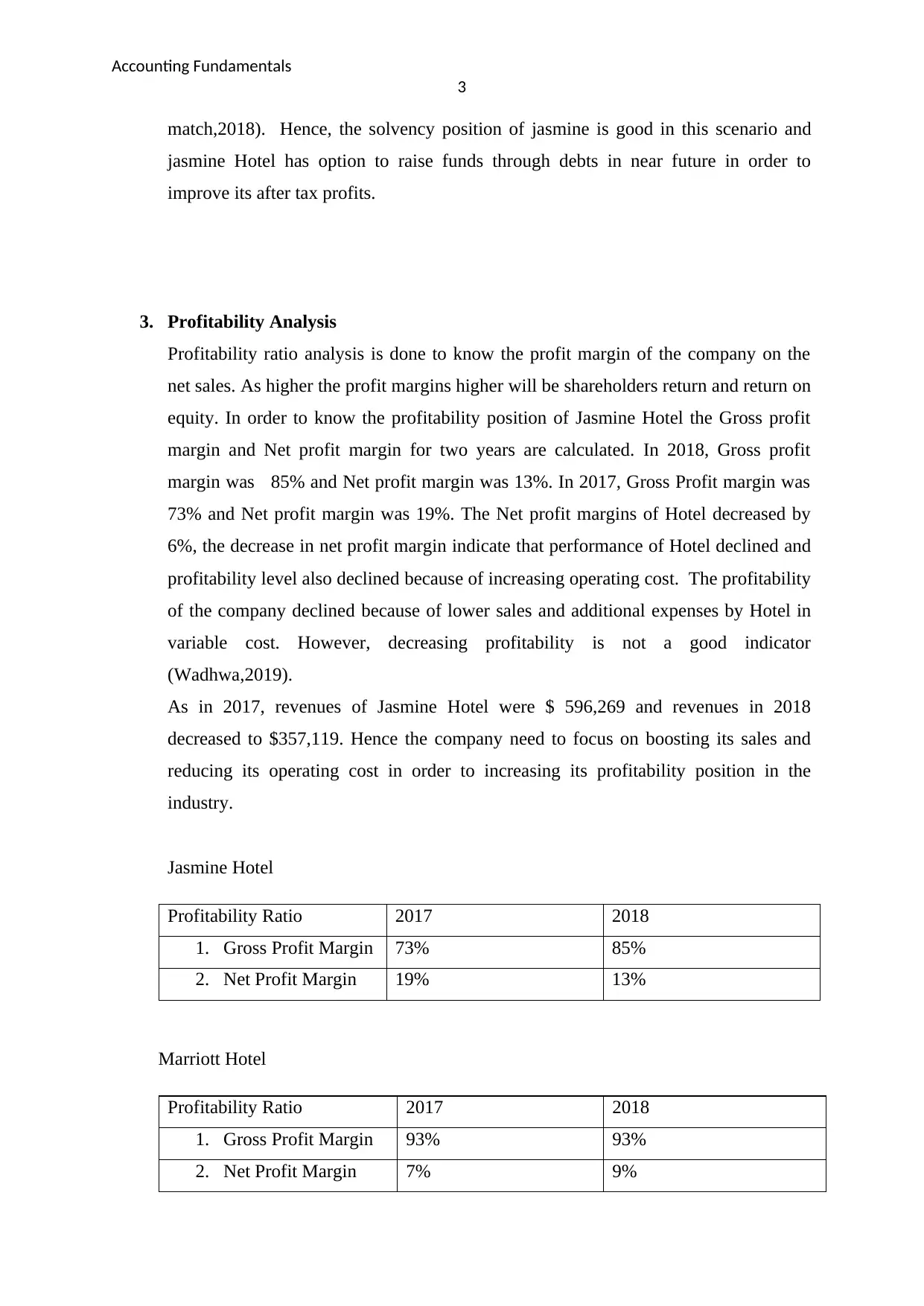
Accounting Fundamentals
3
match,2018). Hence, the solvency position of jasmine is good in this scenario and
jasmine Hotel has option to raise funds through debts in near future in order to
improve its after tax profits.
3. Profitability Analysis
Profitability ratio analysis is done to know the profit margin of the company on the
net sales. As higher the profit margins higher will be shareholders return and return on
equity. In order to know the profitability position of Jasmine Hotel the Gross profit
margin and Net profit margin for two years are calculated. In 2018, Gross profit
margin was 85% and Net profit margin was 13%. In 2017, Gross Profit margin was
73% and Net profit margin was 19%. The Net profit margins of Hotel decreased by
6%, the decrease in net profit margin indicate that performance of Hotel declined and
profitability level also declined because of increasing operating cost. The profitability
of the company declined because of lower sales and additional expenses by Hotel in
variable cost. However, decreasing profitability is not a good indicator
(Wadhwa,2019).
As in 2017, revenues of Jasmine Hotel were $ 596,269 and revenues in 2018
decreased to $357,119. Hence the company need to focus on boosting its sales and
reducing its operating cost in order to increasing its profitability position in the
industry.
Jasmine Hotel
Profitability Ratio 2017 2018
1. Gross Profit Margin 73% 85%
2. Net Profit Margin 19% 13%
Marriott Hotel
Profitability Ratio 2017 2018
1. Gross Profit Margin 93% 93%
2. Net Profit Margin 7% 9%
3
match,2018). Hence, the solvency position of jasmine is good in this scenario and
jasmine Hotel has option to raise funds through debts in near future in order to
improve its after tax profits.
3. Profitability Analysis
Profitability ratio analysis is done to know the profit margin of the company on the
net sales. As higher the profit margins higher will be shareholders return and return on
equity. In order to know the profitability position of Jasmine Hotel the Gross profit
margin and Net profit margin for two years are calculated. In 2018, Gross profit
margin was 85% and Net profit margin was 13%. In 2017, Gross Profit margin was
73% and Net profit margin was 19%. The Net profit margins of Hotel decreased by
6%, the decrease in net profit margin indicate that performance of Hotel declined and
profitability level also declined because of increasing operating cost. The profitability
of the company declined because of lower sales and additional expenses by Hotel in
variable cost. However, decreasing profitability is not a good indicator
(Wadhwa,2019).
As in 2017, revenues of Jasmine Hotel were $ 596,269 and revenues in 2018
decreased to $357,119. Hence the company need to focus on boosting its sales and
reducing its operating cost in order to increasing its profitability position in the
industry.
Jasmine Hotel
Profitability Ratio 2017 2018
1. Gross Profit Margin 73% 85%
2. Net Profit Margin 19% 13%
Marriott Hotel
Profitability Ratio 2017 2018
1. Gross Profit Margin 93% 93%
2. Net Profit Margin 7% 9%
Paraphrase This Document
Need a fresh take? Get an instant paraphrase of this document with our AI Paraphraser
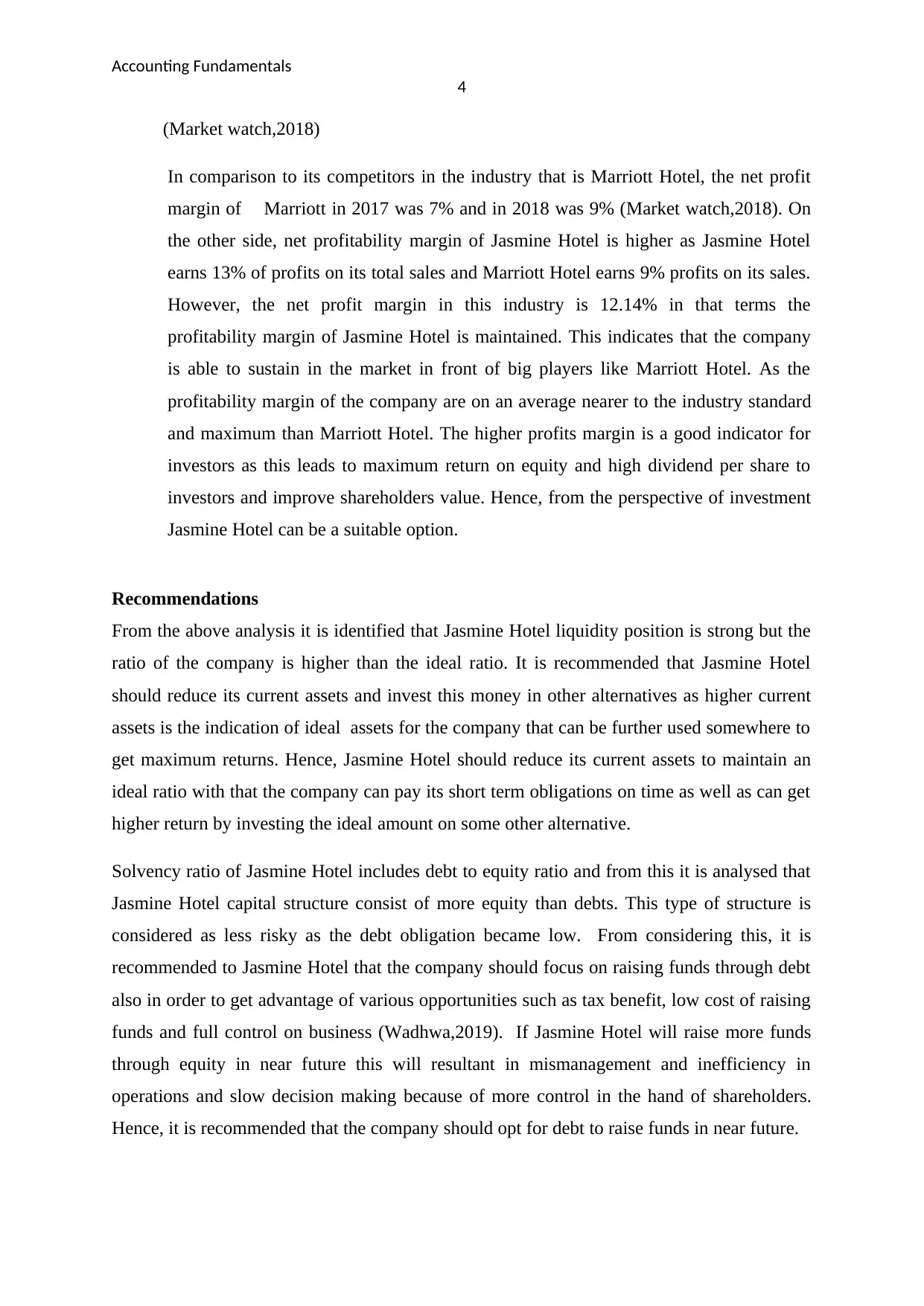
Accounting Fundamentals
4
(Market watch,2018)
In comparison to its competitors in the industry that is Marriott Hotel, the net profit
margin of Marriott in 2017 was 7% and in 2018 was 9% (Market watch,2018). On
the other side, net profitability margin of Jasmine Hotel is higher as Jasmine Hotel
earns 13% of profits on its total sales and Marriott Hotel earns 9% profits on its sales.
However, the net profit margin in this industry is 12.14% in that terms the
profitability margin of Jasmine Hotel is maintained. This indicates that the company
is able to sustain in the market in front of big players like Marriott Hotel. As the
profitability margin of the company are on an average nearer to the industry standard
and maximum than Marriott Hotel. The higher profits margin is a good indicator for
investors as this leads to maximum return on equity and high dividend per share to
investors and improve shareholders value. Hence, from the perspective of investment
Jasmine Hotel can be a suitable option.
Recommendations
From the above analysis it is identified that Jasmine Hotel liquidity position is strong but the
ratio of the company is higher than the ideal ratio. It is recommended that Jasmine Hotel
should reduce its current assets and invest this money in other alternatives as higher current
assets is the indication of ideal assets for the company that can be further used somewhere to
get maximum returns. Hence, Jasmine Hotel should reduce its current assets to maintain an
ideal ratio with that the company can pay its short term obligations on time as well as can get
higher return by investing the ideal amount on some other alternative.
Solvency ratio of Jasmine Hotel includes debt to equity ratio and from this it is analysed that
Jasmine Hotel capital structure consist of more equity than debts. This type of structure is
considered as less risky as the debt obligation became low. From considering this, it is
recommended to Jasmine Hotel that the company should focus on raising funds through debt
also in order to get advantage of various opportunities such as tax benefit, low cost of raising
funds and full control on business (Wadhwa,2019). If Jasmine Hotel will raise more funds
through equity in near future this will resultant in mismanagement and inefficiency in
operations and slow decision making because of more control in the hand of shareholders.
Hence, it is recommended that the company should opt for debt to raise funds in near future.
4
(Market watch,2018)
In comparison to its competitors in the industry that is Marriott Hotel, the net profit
margin of Marriott in 2017 was 7% and in 2018 was 9% (Market watch,2018). On
the other side, net profitability margin of Jasmine Hotel is higher as Jasmine Hotel
earns 13% of profits on its total sales and Marriott Hotel earns 9% profits on its sales.
However, the net profit margin in this industry is 12.14% in that terms the
profitability margin of Jasmine Hotel is maintained. This indicates that the company
is able to sustain in the market in front of big players like Marriott Hotel. As the
profitability margin of the company are on an average nearer to the industry standard
and maximum than Marriott Hotel. The higher profits margin is a good indicator for
investors as this leads to maximum return on equity and high dividend per share to
investors and improve shareholders value. Hence, from the perspective of investment
Jasmine Hotel can be a suitable option.
Recommendations
From the above analysis it is identified that Jasmine Hotel liquidity position is strong but the
ratio of the company is higher than the ideal ratio. It is recommended that Jasmine Hotel
should reduce its current assets and invest this money in other alternatives as higher current
assets is the indication of ideal assets for the company that can be further used somewhere to
get maximum returns. Hence, Jasmine Hotel should reduce its current assets to maintain an
ideal ratio with that the company can pay its short term obligations on time as well as can get
higher return by investing the ideal amount on some other alternative.
Solvency ratio of Jasmine Hotel includes debt to equity ratio and from this it is analysed that
Jasmine Hotel capital structure consist of more equity than debts. This type of structure is
considered as less risky as the debt obligation became low. From considering this, it is
recommended to Jasmine Hotel that the company should focus on raising funds through debt
also in order to get advantage of various opportunities such as tax benefit, low cost of raising
funds and full control on business (Wadhwa,2019). If Jasmine Hotel will raise more funds
through equity in near future this will resultant in mismanagement and inefficiency in
operations and slow decision making because of more control in the hand of shareholders.
Hence, it is recommended that the company should opt for debt to raise funds in near future.
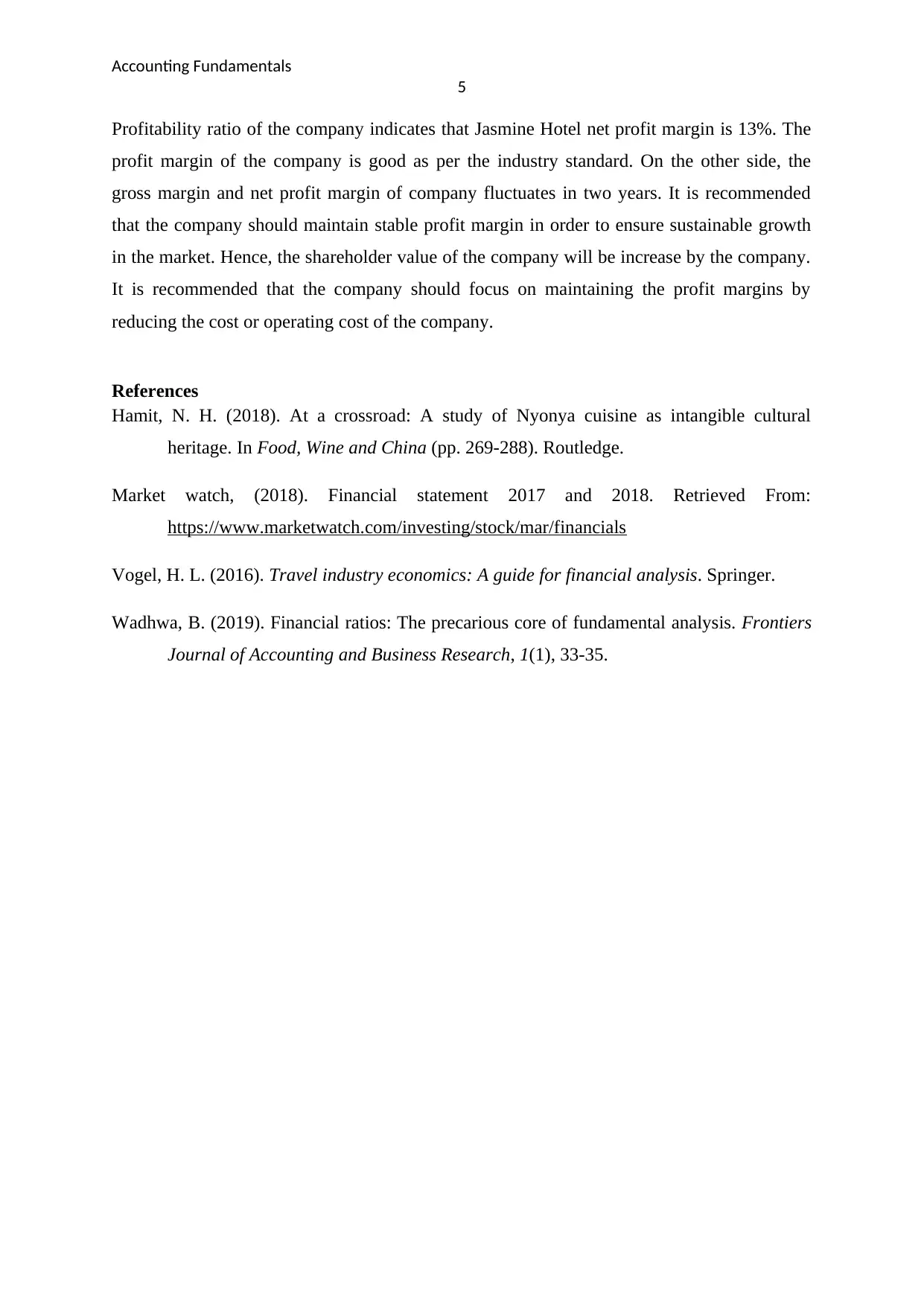
Accounting Fundamentals
5
Profitability ratio of the company indicates that Jasmine Hotel net profit margin is 13%. The
profit margin of the company is good as per the industry standard. On the other side, the
gross margin and net profit margin of company fluctuates in two years. It is recommended
that the company should maintain stable profit margin in order to ensure sustainable growth
in the market. Hence, the shareholder value of the company will be increase by the company.
It is recommended that the company should focus on maintaining the profit margins by
reducing the cost or operating cost of the company.
References
Hamit, N. H. (2018). At a crossroad: A study of Nyonya cuisine as intangible cultural
heritage. In Food, Wine and China (pp. 269-288). Routledge.
Market watch, (2018). Financial statement 2017 and 2018. Retrieved From:
https://www.marketwatch.com/investing/stock/mar/financials
Vogel, H. L. (2016). Travel industry economics: A guide for financial analysis. Springer.
Wadhwa, B. (2019). Financial ratios: The precarious core of fundamental analysis. Frontiers
Journal of Accounting and Business Research, 1(1), 33-35.
5
Profitability ratio of the company indicates that Jasmine Hotel net profit margin is 13%. The
profit margin of the company is good as per the industry standard. On the other side, the
gross margin and net profit margin of company fluctuates in two years. It is recommended
that the company should maintain stable profit margin in order to ensure sustainable growth
in the market. Hence, the shareholder value of the company will be increase by the company.
It is recommended that the company should focus on maintaining the profit margins by
reducing the cost or operating cost of the company.
References
Hamit, N. H. (2018). At a crossroad: A study of Nyonya cuisine as intangible cultural
heritage. In Food, Wine and China (pp. 269-288). Routledge.
Market watch, (2018). Financial statement 2017 and 2018. Retrieved From:
https://www.marketwatch.com/investing/stock/mar/financials
Vogel, H. L. (2016). Travel industry economics: A guide for financial analysis. Springer.
Wadhwa, B. (2019). Financial ratios: The precarious core of fundamental analysis. Frontiers
Journal of Accounting and Business Research, 1(1), 33-35.
⊘ This is a preview!⊘
Do you want full access?
Subscribe today to unlock all pages.

Trusted by 1+ million students worldwide
1 out of 6
Related Documents
Your All-in-One AI-Powered Toolkit for Academic Success.
+13062052269
info@desklib.com
Available 24*7 on WhatsApp / Email
![[object Object]](/_next/static/media/star-bottom.7253800d.svg)
Unlock your academic potential
Copyright © 2020–2025 A2Z Services. All Rights Reserved. Developed and managed by ZUCOL.





